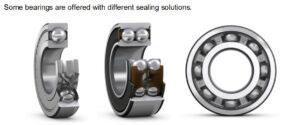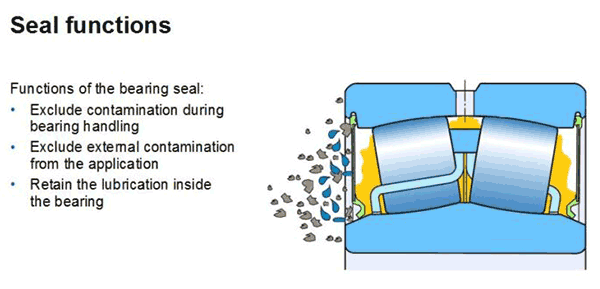Here, we focuse on the basics of different seal designs for bearings. There's always pros and cons to consider during seal or lubrication selection. There isn't one perfect seal type for all, just like there's not one for lubricant for all. So when we're at bearing selection and seal selection, some bearings are only offered open. In this case you can see the bearing is open and you can see the other side. There's nothing peeking out with contamination. There's nothing we can do with lubrication. There's a central bearing here on the right and a double ball bearing. There's black seals on each side of the bearing, those are rubber seals that keep out contamination and keep the grease inside. And then we can also operation with metal shields.

So depending on the bearing's size and the pipe, you might have multiple options. Below we have a double row spherical roll bearing and there's rubber lip seals on either side of this bearing. So what's the function of the seal?

Because the primary function of the seal is to protect the bearing from contaminants, it is important to keep the bearing clean when you take it out of the packaging so you don't contaminate it just by handling it. Another function is, of course, is to make sure the bearing retains the lubricant. We want to keep the grease out, leave supply to the bearing inside so it doesn't leak out and we end up running the bearing dry. Those are the basic functions of seals. So when we're selecting a seal, we're not only weighing pros and cons, advantages and disadvantages, and this is a problem with, with seal selection is that we're trying to balance the sealing efficiency on one side.
So, when we're selecting a seal, we're not only weighing pros and cons, advantages and disadvantages, we're also trying to balance the sealing efficiency on one side. This is the ability of keeping out contamination, keeping out dirt and water, the efficiency of retaining the grease inside the bearing so we don't have it leaking out, and having the ability to not have to remove the bearing. So that's what we want out of seal on one side. But on the opposite side, because of the rubber lip that's making contact with the inner ring, we have the rubber rubbing on the inner ring of the bearing, increasing the friction in the bearing. So it's not going to be as free rotating as it once was.This is also going to add some torque to the bearing and it could end up reducing the speed capability of the bearing. So again, we're trying to balance two trade offs here, sealing efficiency and then the friction related to it.
If you had a bicycle wheel, for example, you would want that bearing to be as free spinning as possible. We don't want to reduce the speed capability of the bearing. If there's a spindle where it's going 20,000 RPM, if we lower the speed capability that could influence the bearing selection and eliminate it as an option for us. And then the sealing efficiency, of course we want to match the efficiency to the application. If we have a food plant and it's mixing flour and we have all that flour around the bearing, we want a seal that will keep all that contamination out as well. And some customers want to be able to lubricate the bearing. So if they do want to lubricate the bearing, they might not want a sealed for life bearing solution.
So these are just a few of the things that must be considered when deciding what kind of sealing configuration best suites your application's needs.

